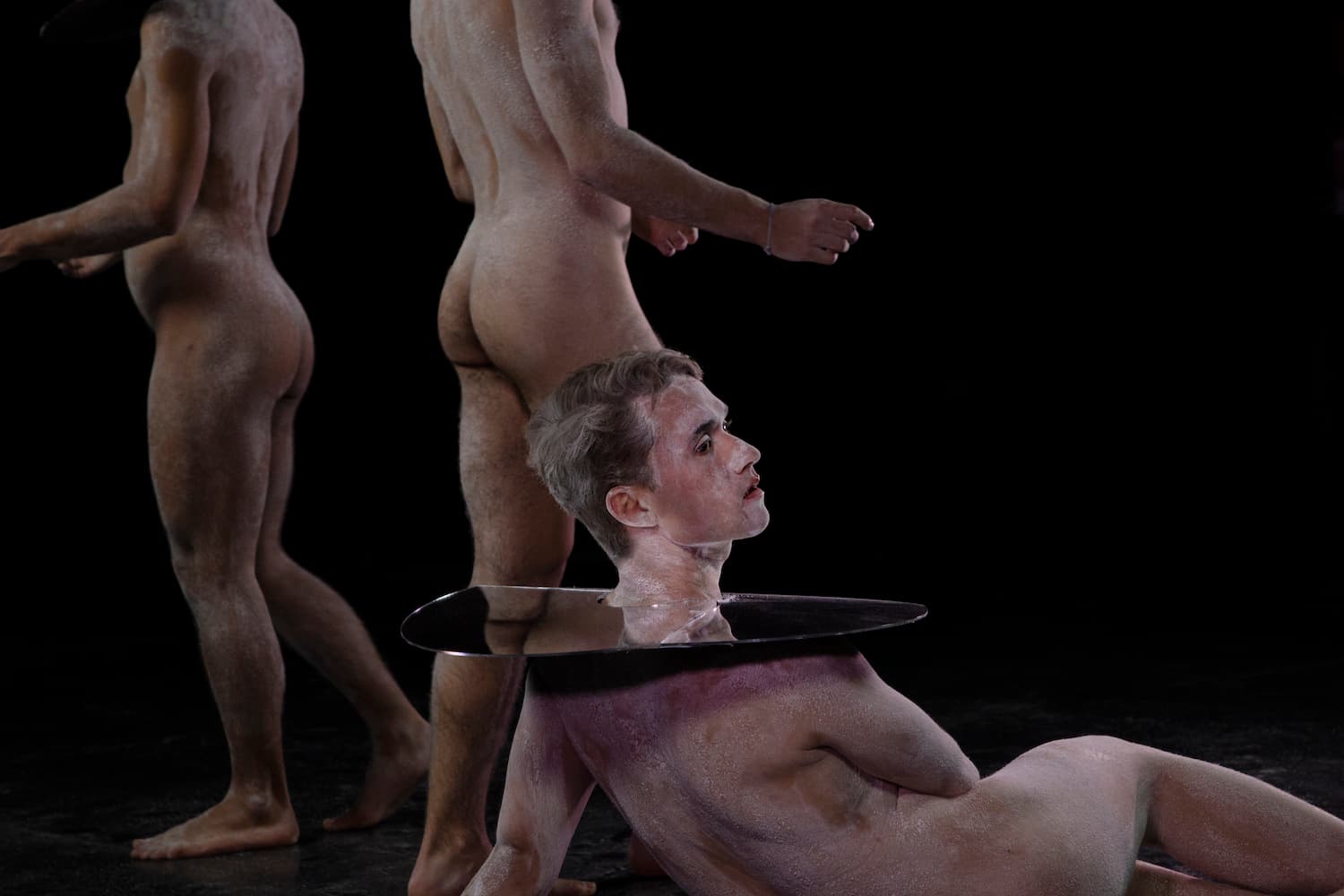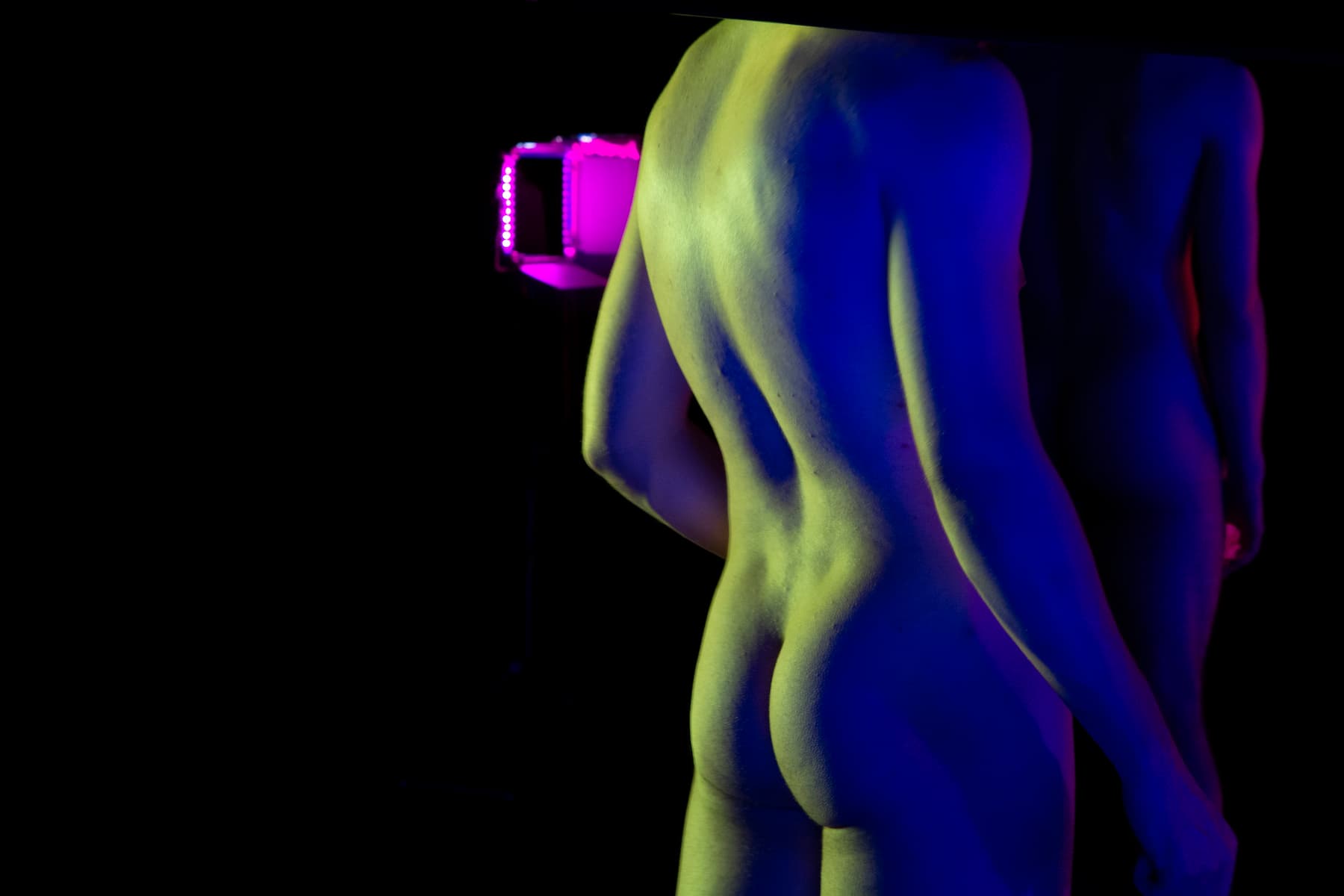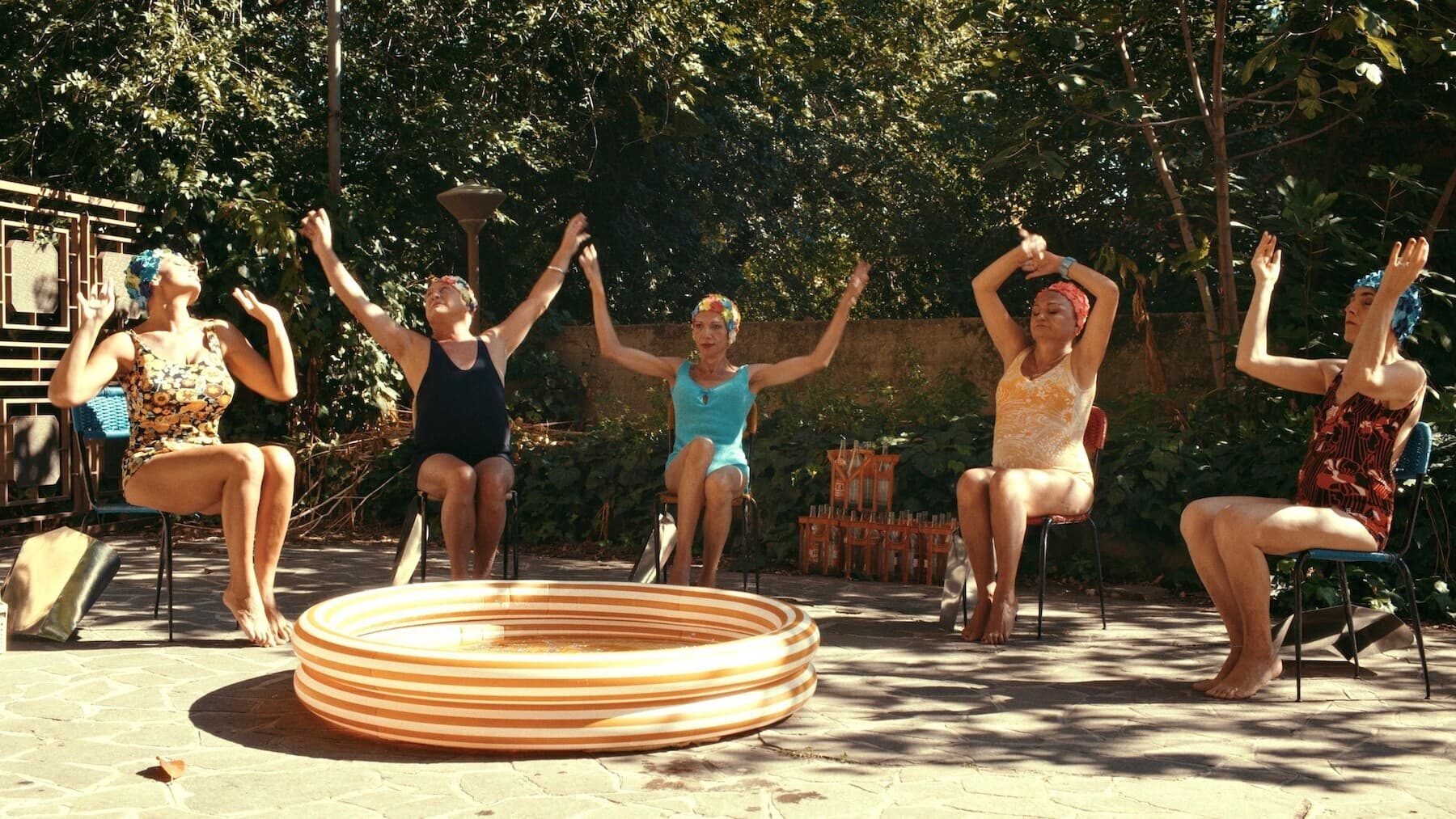
Not Yet Yes
What does queerness without a closet look like? A queerness that defies the existing structures, a queerness that refuses to come out, because you will simply land in a society seeped with encapsulating normativity?
Queerness without a closet questions not just the structure of the closet—the shape, the size, the individualizing enclosure, the material with which it is made. Queerness without a closet especially considers the space outside—where a narrow formulation of freedom appears as the ultimate happy life. Queerness without a closet will tell you there is no inside or outside. Queerness without a closet stirs from an embodied understanding of constant displacement. Harnessing the recognition that any place that offers the experience of a shielded inside, a space to gather—forget about rest; a quiet bed is too much to ask for—will be demolished, refurbished, revitalized, sold on the market. Queerness squats. Queerness practices a position between running and resting.¹ Queerness without a closet formulates a love language for walls that do not hold.²
Often, queerness is presented as a cut. A disruption of a line. A stepping out of the box. A tradition broken. A family falling apart. But queerness might just as much be an insertion. Added time. A slowing down that allows for the insertion of many different voices.³ A sonic cacophony without space widening or stages opening up. A conversation without seats and a table. A refusal to leave the land. A barricade—a body in the picket line or a fist raised from bed⁴—that makes capitalist comfort impossible.
For IDFA, I want a queer day without closets. Confined by the structure of a pre-announced day, the separability of a noted date, I define this attempt as Not Yet Yes. This queer day is not yet a yes, it is not yet a success. It drifts in failure, incompleteness, a liminal stretch for touch and slow transition.⁵ More concretely, the films shown on this day will not end with a yes. Refusing the yes opposes the trend of many documentaries that are cataloged as LGBT or even queer, in which the protagonist moves towards an increased level of comfort. This comfort is likely conflated with “more out”, more proud. Often, this stage of development marks a break with the main character’s home country and freedom is therefore portrayed as a promise behind the walls of Fortress Europe. So often, LGBT documentaries convey a racist humanism that enforces a globalized conception of freedom. This hierarchical thinking portrays freedom as already reached in the most developed nations. It projects a freedom everyone wishes to possess and therefore excuses violence as a means of protection.

Gnosis Illuminada by Agustin Ortiz Herrera. Photo by Daniel Cao. Presented as part of the Not Yet Yes program.
And it is not just LGBT films. Even if there are zero gays on screen, even if heterosexuality flaunts as the normative background of everyone who appears in the film, most documentaries follow the format of a coming out, because the description of the closet is portrayed as the first step towards freedom. People suffer, we see, we learn. Even if the people portrayed do not get to “come out” of their oppressive reality during the film itself, a promise of progress lingers, as we—an audience watching—are witnessing. As viewers, we witness suffering and oppression with a feeling of future potential: us watching, means us learning. Us learning, means us knowing. Us knowing will mean change.⁶ The moral force that drives and funds a documentary film festival is a belief in visibility: if we see, we know. If we know, change can happen. Sadly, this inseparability of knowledge and progress is a colonial project.
Documentaries visualize. “Visualizing,” Nicholas Mirzoeff writes, “is the production of visuality, meaning the making of the processes of ‘history’ perceptible to authority.”⁷ Documentaries do not just portray violence, they reinforce violence. They affirm the most privileged of people in their guilt-ridden feeling that it is their obligation to look at injustice. As if the looking itself is a first step towards taking action against oppression, instead of understanding the act of looking itself as an oppressive grammar. Why are documentaries not flagged as a surveillance technology? The portrayal of real life mostly reproduces how we understand and categorize “real” and “life” and what deserves to exist and preserve livelihood; it cannot aid us in thinking differently about the meaning of “real” and “life” altogether.

Gnosis Illuminada by Agustin Ortiz Herrera. Photo by Daniel Cao. Presented as part of the Not Yet Yes program.
Fiction is dependent on material conditions that are currently utopian. Yes can be imagined when fiction does not need to prove its value by serving a large audience. Yes can be imagined when fiction is free from the ambition to aid our intellectual development and so-called civilization. Yes can be imagined when fiction refuses the outreach of empathy. Yes can be imagined when fiction dares to call itself documentary and documentary dares to call itself fiction. Yes can be imagined when fiction does not produce relatable stories. Yes can be imagined when fiction is no longer viewed as a genre—not for marketing purposes nor as a marker of discipline and skill. Yes can be imagined when fiction refuses the democratic ideal that a story becomes a story when it is understood by many. Yes can be imagined when fiction does not collect and capture what is already possible, but dreams the impossible present. When fiction formulates a politics that does not yet exist. Not by visualizing it, but by inserting the loud absence of impossibility. While fiction requires a willing suspension of disbelief, it does not ask for a yes or for all noses to point in the same direction (to use a Dutch expression).
Not Yet Yes does not signify the absence of yes. Instead, it opens up the potential of an abundance of yesses, as it delays and procrastinates the yes. It projects satisfaction beyond the first encounter with a yes. It imagines so many yesses, that the first possible yes, the first possible agreement, the first encounter with freedom, the first big experience, the first lover, job, pronoun, sex, gender expression, body, kiss, acknowledgement, welcome, arrival, passport, delicious dinner, antiracist dream becomes only one of many. Not Yet Yes signals the political refusal to be satisfied with less.⁸ Not Yet Yes defies police defunding, and desires abolition, and then the abolition of the need for abolition. Not Yet Yes refuses party politics and the democratic majority. Not Yet Yes claims that a yes just to stimulate agreement is always a yes too soon. Yes we can! expressed a premature acceptance: We have not even dreamt all possible meanings of yes and the implied “we” is the wrong we to say yes to.
Not Yet Yes signals that we do not know and cannot know and refuse to know (the value of) consent. In this current world order, how can we trust a yes as enthusiastic consent? How can enthusiastic consent exist, if we have not even practiced multi-layered freedoms to be enthusiastic for? The consent rituals that queers and feminists formulate today are helpful tools for interpersonal survival. But to say we know what yes means, to say we understand consent, is a way too monogamous commitment to the current order of things.
In Times Square Red, Times Square Blue, Samuel R. Delany describes his intimate experiences of the movie theaters on Times Square before gentrification and tourism devoured this part of New York City. It’s the late eighties, early nineties. Delany goes to the movies a lot, and, just like many other men, sits down or scavenges around, seeking sex with strangers and familiar faces. Sometimes the men are homeless. Sometimes the men are professors like him. Sometimes the men have nicknames, such as the Mad Masturbator. Sometimes the men do not want to be touched. Often, they do.

The Fabulous Ones by Roberta Torre. Presented as part of the Not Yet Yes program.
Sometimes the men do not identify as gay. Sometimes they refer to their girlfriend at home or their mother in the hospital. Delany describes what is happening in, on, and between the seats inside the theater, but he also focuses on what is happening outside, on the streets. Shops are closing, sex workers are getting arrested, rents are going up, bars are forced to close down. Policing increases. Before the theaters are pushed out of the city completely and public sex is fully criminalized in the late eighties, the theaters function not only as cruising grounds, but also as a warm hide-out for those who sleep outside. Men chatter and suck dick. The films on screen often show heterosexual porn scenes—Delany observes that the first films were plot driven, later less so. “There were some wonderfully wacky women,” Delany writes, while he considers the guys “absolutely without sex appeal.”⁹
Delany’s account teaches me why I’m interested in film. Not because of what is being shown, but where film is being shown, and how. I believe in cinema not as stories on a screen, but cinemas as actual spaces. Those whom are seeking to spend pleasurable and unproductive hours in the dark have become narrators of displacement, gentrification, and exclusion. My desire for film shows up in the need for spaces where DIY-organization and mutual exchange can happen, where whispers in the dark count as a conversation, where amplification is not necessary, where you can choose a different name each time—if you introduce yourself at all. The films that are shown on the screens in Delany’s essays are important, but not because of the stories and the characters that appear. The films are an excuse, demanding a place to gather. The audience is facing the screen (if not bent over someone’s lap), but not because they need to recognize what is portrayed as their own, nor because they need to agree with what is shown. The encounter happens elsewhere. Relationships are not created through the identitary reach of the storyline, or the director’s attempt to evoke empathy. Impact is not controlled or reproduceable, even if the same film is screened on repeat.
When Delany’s friend Ana asks if she can join, he invites her along. After some adventures—Ana is approached several times, and in response, she asks if she can watch instead of participate in what’s going on—they exit the theater and Ana expresses her surprise:
“it was so easygoing. And you didn’t tell me…” She paused.
“Didn’t tell you what?”
“—that so many people say ‘no.’ And that everyone pretty much goes along with it.”
“I guess,” I said, “when so many people say ‘yes,’ the ‘nos’ don’t seem so important.”
“Well, there’re still more ‘nos’ than ‘yesses.’”¹⁰
The inevitable presence of nos seems to be the prerequisite for having a ton of yesses. Not Yet Yes echoes this: An abundance of yes is unimaginable most of the time, because we do not live in sexy cinemas. We live in a society in which those spaces are eradicated and criminalized. We live in a society where saying no is penalized, sick days are sparse, police orders cannot be ignored, non-reproductive acts are meaningless. Not Yet Yes signals the need for an unapologetic and illegible presence of nos. Nos do not have to be loud and clear, in order to be understood. The deep potential of the no—a no meaning something more than a rejective response to violence and force—needs a space to exist and be explored before dreaming of unimaginable yesses becomes possible.
Coming out further highlights the entitled existence of the closet. Reveals do not lead to change. Visualizing injustice just reproduces the authority of those who have the power to visualize. Only when we have actual spaces and material places where it is safe to say yes yes yes in multiple and incalculable ways, can visibility mean something more than exposure to authority. For queerness without a closet to exist in film, capitalism has to be overthrown.
For queer documentaries to exist, the policing of plush has to seize. In movie theaters, the “welcoming” opening videos that show you the “do not disturb” rules have to go. No more silencing, shushes, or expensive prized tickets. Not Yet Yes signals: We have not yet witnessed queer cinema. We have barely experienced and imagined the material conditions that make queer film possible.
Notes
¹ A position between running and resting does not have to look a certain way. A queerness that squats is not necessarily ableist. It does not live without tools and aids that help us move. Disabled queerness lives with the fugitivity of tools and aids and networks of care—all of which are constantly displaced, taken away, suddenly no longer covered by insurance. A queerness between running and resting, hinges on George Jackson and his letters written from prison: “I may run, but all the while that I am, I’ll be looking for a stick”. Michelle Koerner. “Line of Escape: Gilles Deleuze's Encounter with George Jackson.” Genre 1 June 2011; 44 (2): 157–180, 160.
² “walls that do not hold” nods to the film Adamu Chan made: What These Walls Won’t Hold. Chan started making films while incarcerated at San Quentin State Prison, California. Once released, he continued to work with people inside and outside to get his friends out. What These Walls Won’t Hold focuses on the intimacy and love that is shared between people, exceeding the prison walls. While the abolition of prisons is needed to liberate us all, Chan shows that, amidst state violence, strong relationships are built.
³ Slowing down cannot be equated with “crip time,” but the call to slow down does relate to crip understandings of time. Crip time teaches us not only that some things might take longer or shorter amounts of time than what is normatively prescribed—crip time refers to the ways in which certain speeds and times are assigned to certain behavior (lifting your arm takes a second or two, getting out of bed takes you however many minutes, learning to speak or read takes a child about this many years, we should date for this long before marrying) and disrupts these norms. Most often, crip time is seen as a call to slow down, because disability is portrayed as a hindrance that unsettles the efficient rhythms of a productive life. In Feminist, Queer, Crip, Alison Kafer proposes that crip time can indeed mean “extra” time, or slowing down, but it should more so be regarded as “a reorientation to time”; an appreciation of different velocities and temporalities and an acknowledgment of the many ways bodyminds move (27). Kafer suggests that “rather than bend disabled bodies and minds to meet the clock, crip time bends the clock to meet disabled bodies and minds.” (27) Simon(e) van Saarloos, Against Ageism. A Queer Manifesto (Emily Carr University Press, 2022).
The insertion of many voices might refer to Claudia Rankine and John Lucas’ film Situation 1, in which Zinédine Zidane was assaulted with racial slurs. Zidane, playing his last soccer match before retirement, responded with a headbutt. The few seconds that were played and repeated all over the world, are stretched into minutes by Rankine and Lucas. A daunting heartbeat underlies Rankine’s voice, citing the writing of James Baldwin, Homi Bhabha, Frederick Douglas, Franz Fanon, William Shakespeare, Richard Wright, and Zidane’s own words.
⁴ “the fist raised from bed” cites Johanna Hedva’s text Sick Woman Theory: https://johannahedva.com/SickWomanTheory_Hedva_2020.pdf
⁵ Slow Transitions is a workshop developed by performer Nattan Dobkin. Dobkin wondered whether between the binary male and female, there is more to add than “non-binary” alone. Instead of having another identity category to signal a kind of beyond and in-between, a slow transition might not ever reach one end of a binary, nor choose a middle ground. The workshop Slow Transitions “investigates the temporality of slowness as a method for change. The gathering will explore ‘mythical’ linear movements and how they can become radical when done in slow motion, such as with gender transitions, aging and even the process of committing to a relationship.” To learn more about Dobkin’s work, listen to the Worlding Podcast, “Episode 7.3, Detours and Slow Transitions,” May 4, 2022.
⁶ In Take ‘Em Down, I cite Cathy Cohen and Eve Sedgwick and ask: Does “knowing” help to perpetuate “never again”? Not if we follow political scientist Cathy Cohen in her analysis of racism after the US elections in 2016: White people too have known for a long time what’s going on; there is sufficient proof and there are countless examples to be found. Knowledge does not make people less racist, but ignorance is nevertheless deployed as a strategy for exercising power, Cohen observes. Sedgwick too writes about the power of ignorance. Ignorance is deployed to determine the level and tone of a conversation, to make people explain endlessly what it is that they mean, to make them continually repeat the same thing. Ignorance demands to be met. Sedgwick, like Cohen, is not convinced that additional knowledge makes an effective contribution to combatting inequality. In her essay collection Touching Feeling, she describes a discussion with a friend. Sedgwick is incensed by the possibility that the US Army was involved in the spread of HIV. She demands someone investigate what really happened. Her friend reacts with skepticism to Sedgwick’s indignation. Would it really make any difference if proof was found? She concludes it would not. So many scandals have already been proven factually, and those abuses were not resolved or fundamentally changed. If people only knew, they would do something—that hopeful thought is dangerously naive, Sedgwick concludes. It’s paranoid to think that an underlying, real truth would change everything. We have known for a long time. We don’t need a deeper, more real, and confronting truth to prompt us to act. The fact that we’ve done nothing is more true than the possibility of revealing the truest truth. People know and do nothing. Knowing and remembering do not impart morality. Simon(e) van Saarloos, Take ‘Em Down. Scattered Monumements and Queer Forgetting (Guelph: Publication Studio, 2022), 65-67.
⁷ Nicholas Mirzoeff, The Right to Look. A Counterhistory of Visuality (Durham & London: Duke University Press, 2011), 3.
⁸ “Not Yet Yes” echoes José Esteban Muñoz formulation of queer as “not yet here”. In Cruising Utopia: The Then and There of Queer Futurity, Muñoz writes: “Queerness is not yet here. Queerness is an ideality. Put another way, we are not yet queer.” José Esteban Muñoz, Cruising Utopia: The Then and There of Queer Futurity (NYU Press, 2019), 1.
⁹ Samuel R. Delany. Times Square Red, Times Square Blue. (New York: New York University Press, 2019), 77.
¹⁰ Samuel R. Delany. Times Square Red, Times Square Blue. (New York: New York University Press, 2019), 30.